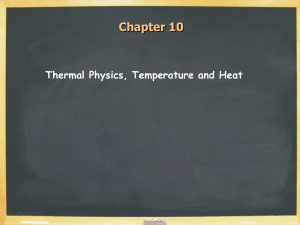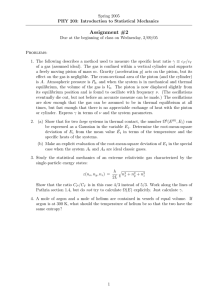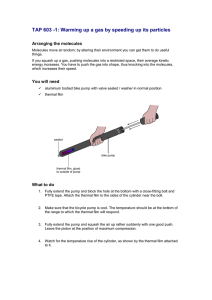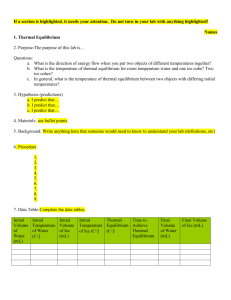Chapter 10
advertisement
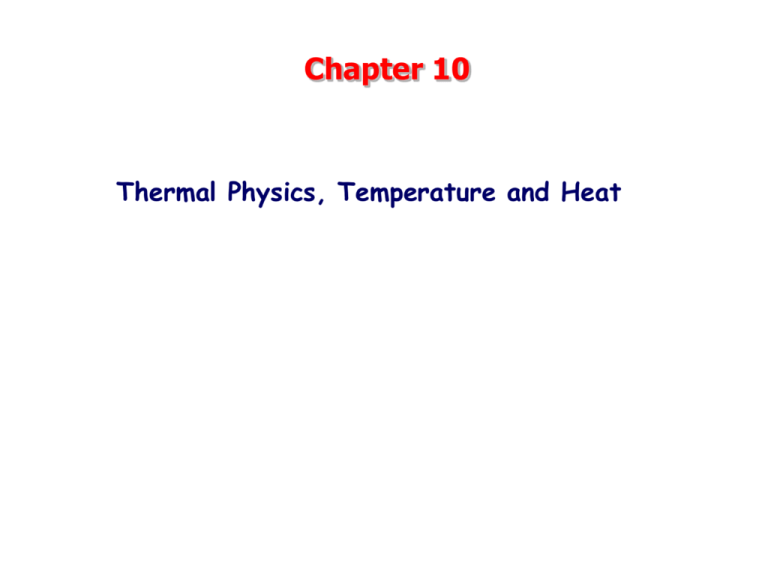
Chapter 10 Thermal Physics, Temperature and Heat Some Vocabulary Thermodynamics: • Study of energy transfers (engines) • Changes of state (solid, liquid, gas...) Heat: • Transfer of microscopic thermal energy Thermal Equilibrium: • Condition after two objects are in thermal contact and finish exchanging heat. Zeroth Law of Thermodynamics If A is in thermal equilibrium with B and B is in thermal equilibrium with C, A is in thermal equilibrium with C. •allows definition of temperature •objects at thermal equilibrium have same T •Heat moves from high T to low T objects Thermometers Exploit temperature sensitivity of • volume or length • • • • pressure electric resistance color average particle speeds Temperature Scales Celsius: • Water freezes at 0 C, boils at 100 C Farenheit: • Water freezes at 32 F, boils at 212 F 9 T (in F) 32 T (in C) 5 5 T (in C) T (in F) 32 9 Absolute Temperature Kelvin Scale: T (in C) T (in K) 273.15 • Lowest possible energy at T=0 K • Energy minimized at T=0 • Ideal gas law only makes sense for absolute scale Some Temperatures • Lowest laboratory T ~ 10-7 K • At RHIC, T ~ 1013 K • In big bang, T ~ 1040 K or more Thermal Expansion • At high T increased molecular vibration pushes molecules further apart L T L0 Coefficient of Linear Expansion Property of Material Area and Volume Expansion Each dimension (length, width & height) stretch L T L0 A T , 2 A0 V T , 3 V0 Example 10.1 The coefficient of volume expansion of water at 20 C is =2.07x10-4 K-1. If the average depth of the ocean is 4000 m, by what height would the oceans rise due to thermal expansion if Earth’s temperature rises by 2 C? 1.65 m If you live on a beach where the slope of the beach is one meter height per 100 meters, how much of your beach would disappear? 165 m (warming doesn't go to all depths, land also expands) Global Warming http://www.ncdc.noaa.gov/oa/climate/globalwarming.html • T rose ~ 0.6 C in last ~ 100 years • T rose ~ 0.25 C in last ~ 25 years Expected to rise from 1.5 to 4 C by 2100 years Should rise higher in mid-upper latitudes • Sea levels rise ~ 1-2 mm per year in last 100 years may rise from 10 cm to 90 cm by 2100 • Melting Antarctic ice caps are important Application: Bimetallic Strip •Used in thermostats Water is Weird • Density INCREASES between 0ºC and 4 ºC • Maximum density of water is 1000 kg/m3 at 4 ºC • Density of ice = 917 kg/m3 .... Ice floats! Ideal Gas Law For sufficiently dilute gas, pressure is: • proportional to number • proportional to temperature • inversely proportional to volume PV nRT pressure temperature Ideal Gas Constant volume number of moles Ideal Gas Law PV nRT • One mole is NA =6.023x1023 molecules (number of 12C atoms in 12 g of 12C) • R=8.31 Nm/moleK Microscopic Perspective PV NkBT Boltzmann’s constant k=1.38x10-23 Nm/K = R/6.023x1023 number of molecules Example 10.2 Pure helium gas is admitted into a leak-proof cylinder containing a movable piston. The initial volume, pressure, and temperature of the gas are 15 L, 2.0 atm, and 300 K. If the volume is decreased to 12 L and the pressure increased to 3.5 atm, find the final temperature of the gas. (Assume helium behaves as an ideal gas.) 420 K Example 10.3 A vertical cylinder of crosssectional area 40 cm2 is fitted with a tight-fitting, frictionless piston of mass 50.0 kg (see figure). If there is 0.15 mol of an ideal gas in the cylinder at 500 K, determine the height h at which the piston will be in equilibrium under its own weight. h=69.5 cm Kinetic Theory of Gases We wish to show: 3 PV E 2 Derivation N px P A t px 2mvx Area=d2 2d t vx 1 px vx2 2 2 1 m mvx KEone part. A t dA V 3V 2 PV KEall part.s 3 Molecular Interpretation of Temperature Using KE=(3/2)PV & PV=NkT, 3 KE Nk BT 2 1 2 3 mv k BT 2 2 kB=1.38x10-23 J/K •Temperature is proportional to the average kinetic energy of a single molecule: Speed of Molecules The root-mean-square (rms) speed of molecules is: 1 2 3 mv k BT 2 2 vrms 3 kB T m Lighter molecules move faster 3RT M Internal Energy • In a monatomic gas, the translational K.E. is the only type of energy the molecules can have 3 U nRT 2 • U is the internal energy of the gas. • In a polyatomic gas, one also has rotational and vibrational energy & (3/2) --> bigger number Example 10.4 A cylinder contains a mixture of helium (4He) and argon (40Ar) gas in equilibrium at a temperature of 150°C. DATA: mproton=1.67x10-27 kg (a) What is the average kinetic energy of each type of molecule? 8.76x10-21 J (b) What is the rms speed of each type of molecule? He: 1.62 km/s, Ar: 512 m/s Example 10.5a Consider the cylinder on the right which is filled with an ideal gas. If P is doubled while maintaining the same volume, T must change by a factor of _______ . a) b) c) d) e) 1/2 21/2 2 4 Can not determine Example 10.5b Consider the cylinder on the right which is filled with an ideal gas. If P is doubled while maintaining the same volume, the r.m.s. speed of the molecules must change by a factor of _______ . a) 1/2 b) 21/2 c) 2 d) 4 e) Can not determine Example 10.5c Consider the cylinder on the right which is filled with an ideal gas. If T is doubled while letting the piston slide freely, the volume will change by a factor of _______ . a) b) c) d) e) 1/2 21/2 2 4 Can not determine
